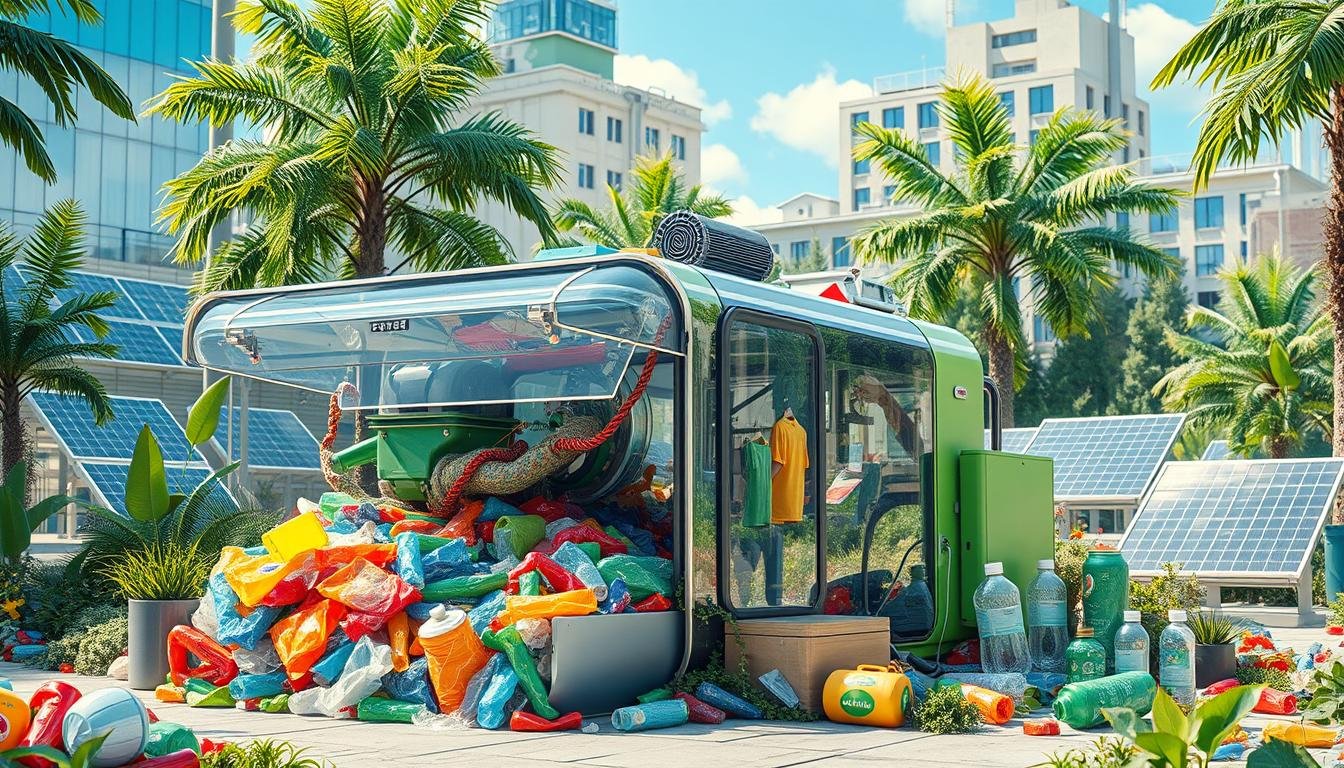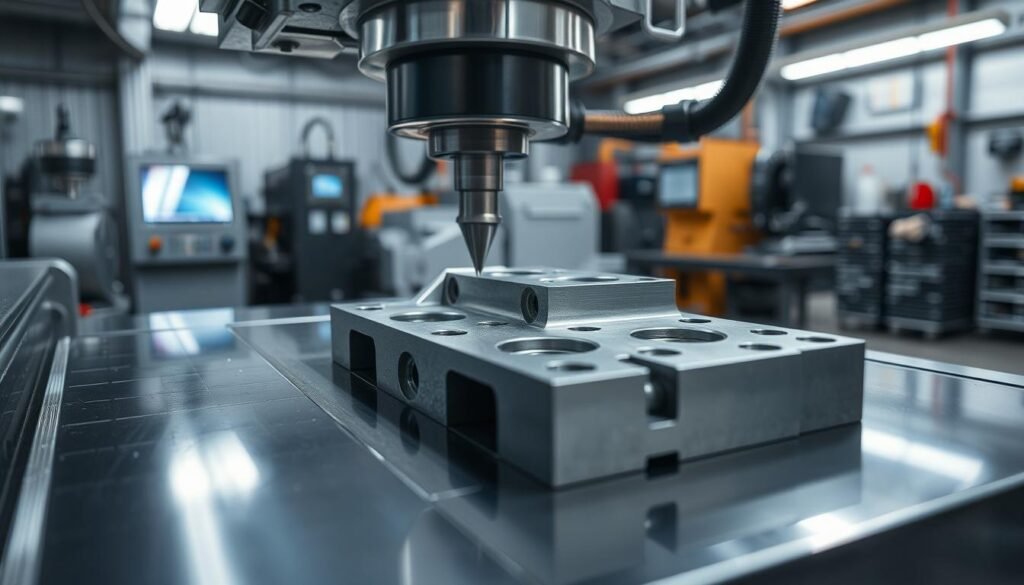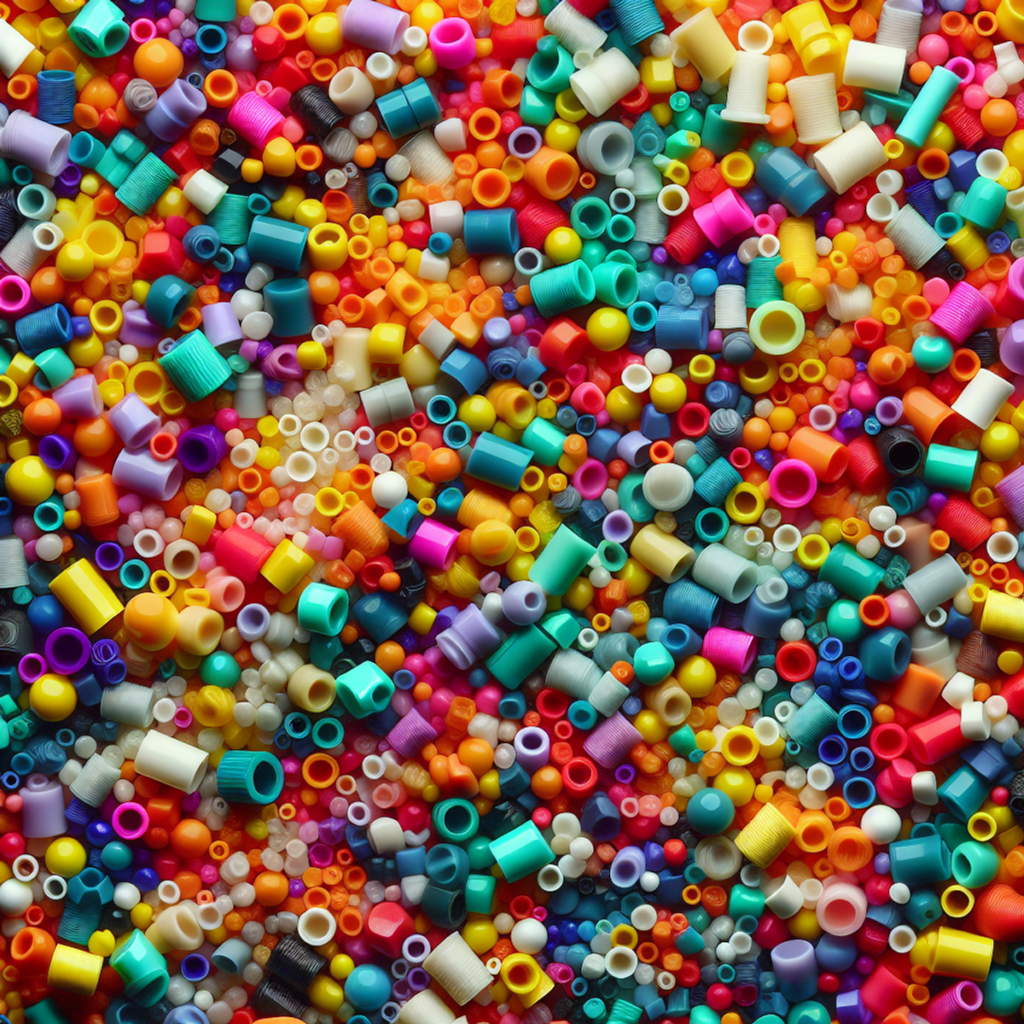Imagine turning all plastic waste into a chance for a better future. From the soda bottle on your desk to your take-out trash, it’s possible. This dream is now reality thanks to recycle technology. With the challenges of plastic waste management growing globally, plastic recycle machines are a big step forward. They’re more than just machines. They signal a move to a circular economy. This marks a change in how we see and use what was once just trash.
TECNOVA is leading the way by combining their expertise with top-notch extrusion lines. This partnership breathes new life into how we deal with PET plastics. It’s not just about changing materials, but changing attitudes. Their machines can handle 250 kg of plastic per hour. This capability is huge for both the environment and industries.
The advancements don’t end with processing power. TECNOVA has made their extrusion lines smart. Automation makes recycling smoother and more efficient. They produce 1000 units annually. This means recyclers from all over, including Europe and Poland, can make sustainable products from plastic.
Key Takeaways
- TECNOVA leads with extrusion lines that elevate recycling to new heights of efficiency.
- Customizable solutions mean various types and volumes of plastic can be transformed into valuable resources.
- Intelligent automation and engineering ensure optimized processes for maximum output and reduced energy consumption.
- Recycle technology reinforces sustainability by enabling continuous 24-hour operation with minimal environmental impact.
- Success stories across Europe highlight the tangible benefits of advanced plastic waste management.
Introduction to Plastic Recycling and Its Global Impact
Plastic recycling has become key in fighting plastic waste that fills our earth and seas. The impact of plastic recycling goes beyond handling waste. It helps in economic growth and conserves resources, supporting sustainable ecosystems worldwide.
The world is facing a massive plastic waste problem. Global recycling solutions are now more crucial than ever. The U.S. alone produced about 44 million tons of plastic waste in 2019. This shows a dire need for effective recycling to lower environmental risks.
The Need for Small-Scale Recycling Solutions
Small-scale recycling solutions are crucial in the fight against plastic pollution at the local level. Affordable, accessible technologies let small businesses and individuals help save our environment. For example, compact recycling machines from Genius Machinery can process up to 1100 kg of plastic each day. They do this without the need for big infrastructure.
These machines help small businesses join the recycling world and create green jobs. This boosts the local economy and cuts down on trash in landfills. Learn more about how these small machines have a big impact.
Positive Global Impact of Plastic Recycling
The global impact of plastic recycling is huge. Recycling plastic waste lowers the need for new plastics. In 2021, making new plastics added 450 million metric tons of greenhouse gases. Small-scale recycling helps solve this by turning waste into valuable resources.
Right now, only 5-6% of plastics are recycled well. There’s a lot of room to do better in the recycling field. Increasing recycling rates and adopting new technologies can greatly help the environment. This can save energy, preserve natural resources, and reduce pollution.
Worldwide efforts towards sustainability depend on strong small-scale recycling practices. Making recycling easier for more communities globally helps fight plastic pollution more effectively. By promoting local recycling, we’re making a bigger impact on global recycling success, combating plastic pollution.
By using less plastic and improving recycling technologies, we can aim for a sustainable, pollution-free world. This broad approach highlights the need to improve global recycling solutions. It’s about creating a future that’s environmentally safe.
Understanding the Circular Economy and Plastic’s Role
Today, it’s vital to adopt a circular economy, especially for managing plastics. Instead of the usual ‘take-make-dispose’ model, resources like plastics are used for as long as possible in a circular economy. This method results in less waste and conserves resources, highlighting the plastic recycling benefits.
The goal is to revamp how we produce and use plastics. By doing this, we aim to cut down waste and make recycling a standard practice. This big change contributes to waste reduction and adds value economically. It puts recycled plastics back into the supply chain effectively.
Characteristics and Benefits of Recycled Plastic
Recycling plastics offers many benefits, both green and financial. Recycled materials need less energy to make than new plastics. They also emit fewer greenhouse gases. This process saves natural resources and supports sustainability. Economically, it lowers expenses related to waste management and buying raw materials.
Closing the Loop: From Waste to Resource
Advancements in recycling technology are turning plastic waste into precious raw materials. The push for a circular economy grows as more firms invest in such technologies. These efforts reduce waste and enhance global economic health by reusing materials in manufacturing.
| Statistic | Plastics | Metals |
|---|---|---|
| Recycling Rates (U.S., 2021) | 8.7% | 52-76% depending on type |
| Landfill Disposal | 40% | 29-54% |
| Carbon Emission Reduction Potential from Total Recycling | 25% | Varies significantly by type |
In summary, plastic plays a transformative role in the circular economy. It’s about changing how we manage resources to highlight the plastic recycling benefits. Integrating recycling initiatives can lessen environmental harm and pave the way for a sustainable future.
The Process of Transforming Plastic Waste into New Products
The recycling process turns old materials into valuable resources again. It changes plastic waste into new products. This helps the environment and leads to new recycling ideas. Let’s look at how plastic waste becomes useful items.
From Collection to New Product: The Six Steps of Recycling
Recycling starts with collecting plastics from places like homes and businesses. After collecting, recycling involves many important steps:
- Sorting Techniques: A mix of manual and machine sorting separates plastic from other materials. Tools like Trommels and Optical Sorters are key.
- Washing and Drying: This step cleans the plastic and gets it ready for the next steps. It ensures the recycled material is of good quality.
- Shredding/Grinding: The plastic is broken into small pieces, which makes it easier to handle.
- Extrusion: The small pieces are melted and turned into pellets. These pellets are the start of making new products.
- Molding/Injection: The pellets are shaped into new items. This is how waste becomes useful again.
The recycled plastics are then used to make all sorts of things. This shows how we can turn waste back into something valuable.
Exploring the Different Applications of Recycled Plastic
Recycled plastic is used in many areas like packaging and building. It’s also found in clothes and cars. Re-using plastic changes industries. It reduces waste and saves raw materials. This helps our planet and keeps things sustainable.
The recycling journey is complex but offers great benefits. It’s good for the earth and the economy. As we improve in recycling, more plastic waste will become useful products.
Community Involvement: Everyone Can Be a Recycler
Every person’s effort in recycling shapes a green neighborhood. By joining community recycling programs, we all help reduce plastic waste. This improves our planet’s health.
Community recycling includes many activities, like curbside collection and learning programs. All these actions are key. They build a culture of environmental care and responsibility.
Adding recycling to school lessons teaches students how to live sustainably. This has a big individual impact. Recycling drives for e-waste and clothes also reduce plastic waste. They help save resources in our towns.
- Active recycling centers help collect more materials during clean-up events. This shows our joint responsibility for the environment.
- Composting in communities cuts down greenhouse gases. It shows the environmental perks of community recycling.
- When local shops stop using single-use plastics, it shows how community recycling helps businesses too.
The tables below display data on recycling centers and how many people join in. This data proves community efforts are key to recycling success:
| State | Walmart Supercenter Locations | Sam’s Club Locations |
|---|---|---|
| Arkansas | 3 | 4 |
| Texas | 10 | 11 |
| Oklahoma | 9 | 4 |
| Louisiana | 6 | 2 |
The numbers tell us how each person can join in recycling. This shows the wide reach of our community efforts. Together, we achieve our sustainability goals and reduce our environmental footprint.
It’s not just up to those who make laws to reduce plastic waste. We all have a role to play. Every recycled item, every new person joining recycling efforts, helps make our towns cleaner and greener. Our collective actions and dedication are what make community recycling work well.
In-Depth Look at Plastic Recycle Machines
The world of recycling technology is changing fast, thanks to plastic recycle machines. These machines make recycling more efficient and effective all over the world. They play a key role in plastic shredding and recycling, which helps with environmental sustainability.
At the heart of the recycle machine function is turning waste into useful things. This involves cool technologies like Reverse Vending Machines (RVMs). You can find RVMs in places like supermarkets, where they make recycling easy and even give you rewards like refunds or coupons. This boosts recycling efforts a lot.
Using more RVMs in the US could really help our so-so recycling rates. Look at Germany – their recycling rates are over 70%! If we use this recycling technology more, we could see similar success. These machines collect materials cleanly and sorted, cutting down on contamination.
Another cool tool is the Precious Plastic Extrusion machine, made by the Design Academy in 2016. It’s awesome for plastic shredding and molding. The Extrusion Pro model even caters to big production needs. It shows how we’re moving from manual to automation in recycling, making it way more efficient.
These machines are really flexible and adaptable. They work with many molds to make all sorts of items, from beams and bricks to vases and trays. This variety encourages small-scale recycling and creativity in making recycled plastic items.
As we move ahead, new recycling technology will be more energy-efficient and compact. This matches the world’s goal to be more sustainable and reduce our environmental footprint. Plastic recycle machines are key to better recycling methods.
The Philippine Initiative: Turning Waste into School Chairs
In the Philippines, Envirotech Recycling has started an amazing project. They focus on turning plastic waste into something useful. This helps stop environmental damage and shows how we can reuse resources better.
Envirotech Recycling Inc.’s Holistic Approach
Envirotech Recycling is leading the way in recycling in the Philippines. They’ve found a new way to make school chairs from old plastics. This year, they’ve handled about 2.5 million kilograms of waste. They turn things like sachets and plastic cups into strong school furniture.
Creating Livelihood and Environmental Benefits
The recycling process does more than just reuse materials; it also creates jobs. Envirotech Recycling helps the community by providing work and dealing with an environmental problem. Each chair uses about 20 to 30 kilograms of waste. This reduces a lot of plastic waste.
This project also shows us how much single-use plastic we use in the Philippines. Every day, Filipinos use around 212 million plastic sachets and bags. Turning these into chairs helps kids learn in a better environment. It also teaches them to care for our planet.
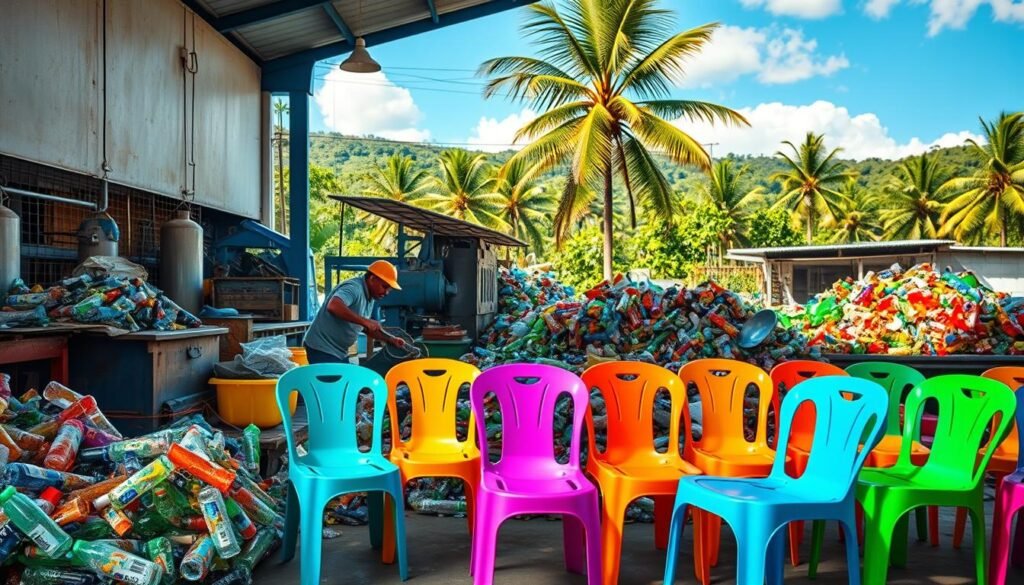
| Type of Plastic Waste | Quantity Used for One Chair (kg) | Yearly Processing Capacity (kg) |
|---|---|---|
| Mixed Plastic (sachets, cups, wrappers) | 20-30 | 2,500,000 |
| Total Waste Used Annually | Approximately 60 billion sachets | |
Envirotech Recycling is making a big difference with their recycling techniques. They’re solving waste management problems and helping the environment. Their work shows how businesses can help make a better future. They offer real benefits to the community and the planet.
Local Manufacturing: Recycling Machines ‘Made in Austria’
In this time, making things sustainably is key. Austrian made recycling machines are known for their high quality and safety. Not only do they transform waste into something useful, but they also show off top-notch engineering and eco-friendly production.
Quality and Safety Standards in Production
Austrian creators are famous for their quality recycling equipment. Each machine is tested thoroughly and meets global safety standards. From start to finish, these machines manage safe plastic processing with great care. This shows the dedication and precision of Austrian manufacturing.
The Importance of Localized Machine Production
Making Austrian made recycling machines is about more than just quality. By getting parts and materials nearby, makers help the local economy and reduce the harm of shipping stuff far. This move to local making helps communities by creating jobs and teaching people new tech skills.
Here’s a table that shows how local making helps the planet and people. It uses Austrian innovations as an example:
| Statistic | Details |
|---|---|
| Recycled Products Manufactured | Hundreds of thousands |
| Individuals Educated on Recycling | Thousands |
| Jobs and Skills Developed | Hundreds |
| Plastic Returned to the Loop | Tons |
| Custom High-quality Objects Created | Extensive range possible |
| Local Suppliers Utilized | Frequently |
The facts show how Austrian made recycling machines help the environment and economy. They do this through local production and by sticking to safe plastic handling rules.
Debating the Effectiveness of Plastic Recycling Technology
The recycling debate is hot. People are looking at the environmental impact of recycling and how it helps with plastic pollution. With more plastics around, we need smart plastic reduction strategies now more than ever.
Environmental Considerations and Solutions
We’re facing a big task. There’s a need to tackle the growing waste and cut down on new plastic production. Moving towards a circular economy means creating broad strategies. These should include redesigning packaging for better recycling and less damage to the environment.
Here’s something to think about – over two trillion pounds of solid waste is made every year around the globe. A big chunk of this is plastic. This shows why we need strong recycling systems able to deal with different types of plastic.
Challenges and Potential of Recycling Technologies
Some question if recycling really works given its economic and logistical hurdles. In the U.S., only a small amount of recyclable plastics get recycled. There’s a big difference between what could be done and what’s actually happening.
But there’s more to the story:
- Limited Recycling Infrastructure: Many areas just don’t have the right tools or systems for efficient recycling.
- Economic Viability: Changing oil prices can make recycling less profitable. Often, new plastics are cheaper, so people use those instead.
- Advances in Technology: Putting money into new technologies like chemical recycling and bioplastics could change the game.
Getting different industries to work together and educating the public about recycling could make a big difference. This can help recycling technologies get better.
| Challenge | Impact | Proposed Solution |
|---|---|---|
| Contamination in Sorting | Reduces recyclability of materials | Improve sorting facilities and public education on waste disposal |
| Economic Factors | Lowers investment in recycling technology | Support policies favoring recycling over virgin material production |
| Technological Limitations | Stifles potential for high-quality recycled products | Invest in R&D for advanced recycling processes |
Collective Action: The Key to a Sustainable Plastic Recycling Future
True sustainability in plastic recycling needs more than new technology. It requires joint environmental efforts and a common future vision. With the huge challenges from plastic waste, we must use holistic sustainable recycling practices. These should be backed by strong waste management collaboration among different groups.
Embracing a Shift in Consumption and Waste Attitudes
About 50% of plastics are used once and then thrown away. This leads to massive waste. We need to change how we use and recycle plastics at all levels of society. New recycling methods are crucial for using materials multiple times without loss of quality.
Government, Industry, and Citizens Working Together
For recycling to truly work, governments, companies, and people must collaborate in waste management collaboration. This teamwork needs to look at how recycling machines work. But also, the laws and community support for joint environmental efforts.
In places like Asia-Pacific, the plastic pile-up is huge. The Plastic Collective shows the need for projects that mix government policy, industry innovation, and community action. Their machines and training show how everyone’s efforts can bring economic and environmental gains together.
Sustainability in plastic recycling comes from high-tech recycling machines and in-depth training on reducing, recovering, and reusing plastics. Success depends on everyone working together to make recycling more effective.
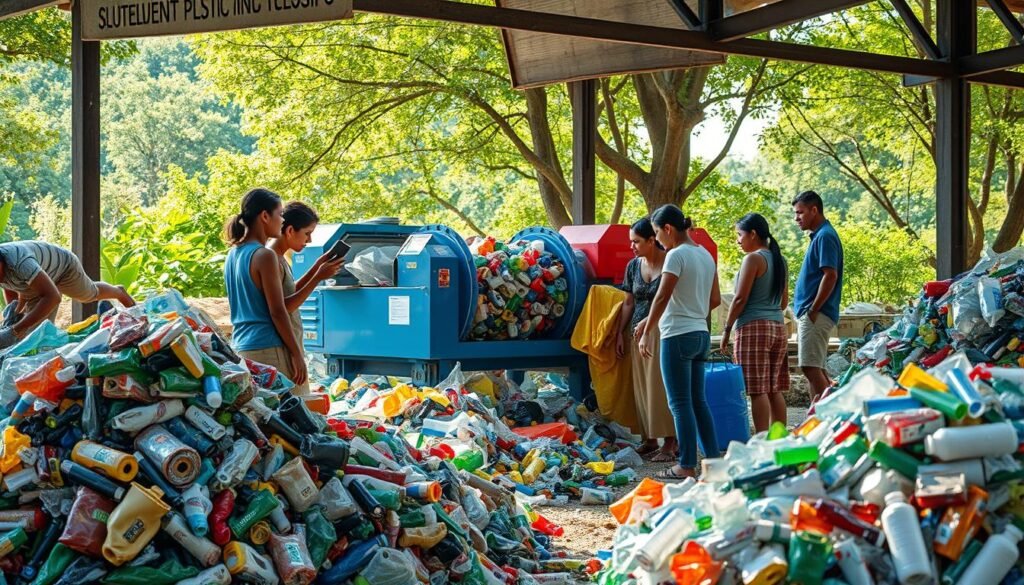
By pushing for these group actions, every person involved helps build a recycling system that’s good for both our economy and the Earth. Moving forward, focusing on sustainable recycling practices and waste management collaboration will help reduce plastic pollution. This protects our world for those who come after us.
Staying Informed and Connected with Plasticpreneur
The world is working hard on sustainable waste management and recycling. It’s crucial to stay updated with recycling innovation updates. Being part of a sustainable solutions network is essential. Plasticpreneur leads the way in recycling, pushing us towards a better economy.
Plasticpreneur plays a key role in solving global crises. They quickly produced personal protective equipment (PPE) when it was needed. By turning plastic waste into useful products, they show their skill and care for society. During the pandemic, they made thousands of protective visors quickly.
- 20,000 visors produced for Dresden area hospitals using recycled plastic.
- 3,000 face visors manufactured in Gran Canaria for government and healthcare providers.
- Innovative collaborations with companies like Alumoulds and initiatives like Precious Plastic Leman to create hands-free door handles, crucial for minimizing COVID-19 transmission.
Plasticpreneur can change their production fast. This shows how important recycling innovation updates are. Their ability proves the strength of the sustainable solutions network.
Plasticpreneur helps build a community caring for the environment. Their newsletter keeps subscribers informed about new developments and ways to help the environment.
Through their work, Plasticpreneur promotes recycling and supports our world. They help us face environmental and humanitarian issues, aiming for sustainability and resilience.
Conclusion
Plastic recycle machines are more than just tech advancements. They are leading the way in recycling. These machines handle different types of plastics – PET (#1), HDPE (#2), PVC (#3), LDPE (#4), PP (#5), PS (#6), and others (#7). They break down plastics into materials we can use again. This helps us move towards sustainable living.
Shredders, granulators, extruders, and densifiers play a key role in giving plastics a new life. They transform waste into usable forms. This reduces the waste problem.
The impact of these machines on the environment is significant. They turn hard plastics into small pieces or pellets. This action reduces pollution and promotes a healthier planet. Also, creating jobs in the recycling sector shows the positive effect of this technology on society.
Choosing the right machine is vital for recycling success. It depends on the plastic type, how much can be processed, and the method used. Making the right choice is critical.
Plastic recycling is crucial in industries like packaging and manufacturing. Overcoming obstacles such as unstable material input and pellet contamination is key. We must also prevent overheating and ensure pellets are uniform.
Ensuring high-quality recycled products means solving problems like hollow pellets and stickiness. Proper operation and maintenance are crucial. The goal is a circular economy, where no plastic is wasted. This shows our dedication to protecting the planet.
FAQ
What is a plastic recycle machine and how does it contribute to waste management?
A plastic recycle machine turns plastic waste into new, valuable items. It helps the environment by changing waste into resources. This reduces the trash at landfills.
How do small-scale recycling solutions impact global sustainability?
Small-scale recycling lets people and small communities join the recycling effort. This helps the environment a lot. It also provides ways to make money and learn new skills, tackling the plastic waste issue.
What is the circular economy and what role does plastic recycling play in it?
The circular economy aims to get rid of waste and keep using resources. Plastic recycling is key here. It cuts down waste and makes sure materials are reused. This keeps plastic in use and out of the trash.
Can you describe the process of transforming plastic waste into new products?
The process starts with collecting and sorting plastic waste. It’s then washed, dried, and shredded. The material is shaped through injecting or extruding, then molded. Finally, the recycled plastic becomes a variety of products. This shows how recycling can benefit us.
How can communities be a part of the recycling process?
Communities can help by joining local recycling programs. They can act together to lessen plastic waste. Using plastic recycle machines turns waste into useful items. This promotes clean living and sustainability.
What are the functionalities and features of plastic recycle machines?
Plastic recycle machines are easy to use and very practical. They offer support and help users find markets for products. These machines usually shred plastic into material that can be reused.
How is the recycling initiative in the Philippines utilizing plastic waste?
In the Philippines, Envirotech Recycling turns plastic waste into school chairs. This fights the plastic pollution problem. It also creates jobs for people.
Why is local manufacturing of recycling machines important?
Building recycling machines locally follows important safety and quality standards. It boosts the local economy. And it improves recycling technology over time.
What are the main challenges and potentials of plastic recycling technologies?
Recycling technologies face some issues, like possibly leading to more plastic use. But they have big benefits. They reduce waste and help us live more sustainably.
How important is collective action for a sustainable future in plastic recycling?
Working together is crucial for recycling success. Changing how we think about waste is a start. Everyone, including governments and businesses, needs to help. This makes our growth work with nature, not against it.
How does Plasticpreneur help individuals and organizations stay informed about recycling?
Plasticpreneur keeps people up to date on recycling. Their newsletter offers news on tech and opportunities. It helps build a community that cares about the planet.



